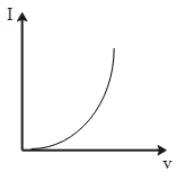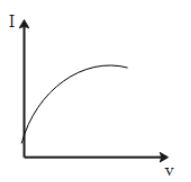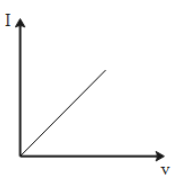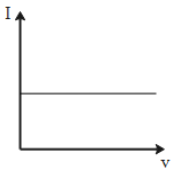
The V-I characteristics of four circuit elements are shown below. Which among the following is an ohmic conductor?
A.

B.

C.

D.





Answer
561k+ views
Hint: According to ohm’s law the voltage drop across a conductor is directly proportional to the current flowing in it. This law is only valid when external factors such as temperature remain constant. If the temperature changes around the current-carrying material different materials act differently according to their properties.
Complete step by step solution:
The material which follows ohm's law is termed as ohmic conducting material (ohmic conductor).
Ohm's law states that the voltage drop across a conductor is directly proportional to the current flowing in the closed path in constant external conditions.
$V\propto I$
So when the value of the voltage drop increases the current flowing through the circuit will also increase.
This proportionality can be resolved with the introduction of a proportionality constant.
$V=RI$
This proportionality constant ($R$) is known as resistance. It is an internal property of the material.
The value of the resistance for any circuit can be calculated by taking the ratio of voltage and the total current flowing through the circuit.
$R=\dfrac{V}{I}$
When a lot is drawn between the voltage and current, as the value of voltage increases the value of current will also increase. This will form an increasing straight-line graph from the origin.
The slope of the plotted graph will represent the value of the resistance in the circuit.
Thus from the above discussion, it can be concluded that, among the graphs mentioned in the option which represents the graphical representation of an ohmic conductor is Option C.
Note:
Ohm's law has a drawback that it is not able to explain the relation between voltage and current in complex circuits which includes passive elements like capacitor and inductor. It also failed to explain the superconductivity behavior of the conductors. But this law is still used to solve linear circuits.
Complete step by step solution:
The material which follows ohm's law is termed as ohmic conducting material (ohmic conductor).
Ohm's law states that the voltage drop across a conductor is directly proportional to the current flowing in the closed path in constant external conditions.
$V\propto I$
So when the value of the voltage drop increases the current flowing through the circuit will also increase.
This proportionality can be resolved with the introduction of a proportionality constant.
$V=RI$
This proportionality constant ($R$) is known as resistance. It is an internal property of the material.
The value of the resistance for any circuit can be calculated by taking the ratio of voltage and the total current flowing through the circuit.
$R=\dfrac{V}{I}$
When a lot is drawn between the voltage and current, as the value of voltage increases the value of current will also increase. This will form an increasing straight-line graph from the origin.
The slope of the plotted graph will represent the value of the resistance in the circuit.
Thus from the above discussion, it can be concluded that, among the graphs mentioned in the option which represents the graphical representation of an ohmic conductor is Option C.
Note:
Ohm's law has a drawback that it is not able to explain the relation between voltage and current in complex circuits which includes passive elements like capacitor and inductor. It also failed to explain the superconductivity behavior of the conductors. But this law is still used to solve linear circuits.
Recently Updated Pages
Master Class 11 Economics: Engaging Questions & Answers for Success

Master Class 11 English: Engaging Questions & Answers for Success

Master Class 11 Social Science: Engaging Questions & Answers for Success

Master Class 11 Biology: Engaging Questions & Answers for Success

Class 11 Question and Answer - Your Ultimate Solutions Guide

Master Class 11 Business Studies: Engaging Questions & Answers for Success

Trending doubts
What is meant by exothermic and endothermic reactions class 11 chemistry CBSE

10 examples of friction in our daily life

One Metric ton is equal to kg A 10000 B 1000 C 100 class 11 physics CBSE

Difference Between Prokaryotic Cells and Eukaryotic Cells

What are Quantum numbers Explain the quantum number class 11 chemistry CBSE

1 Quintal is equal to a 110 kg b 10 kg c 100kg d 1000 class 11 physics CBSE




